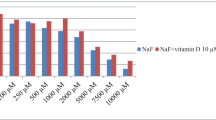Abstract
Epidemiological, experimental and clinical data indicate that cadmium and lead are osteotoxins in man and other species. The relative sensitivities of a clonal human osteosarcoma cell line (HOS TE 85) and a clonal rat osteosarcoma cell line (ROS 17.28) to the cytotoxic effects of cadmium and lead were tested in serum-free media without added growth factors. The rat osteosarcoma cells were more sensitive to cadmium with cytotoxicity and inhibition of proliferation at 0.25 versus 0.75 and 1.0 μmol l− cadmium, respectively, for human osteosarcoma cell lines. The lower sensitivity to cadmium of human osteosarcoma cells is attributed, at least partly, to induction of metallothionein synthesis by cadmium and zinc in this cell line; in the rat osteosarcoma cell line, they do not induce metallothionein synthesis. Human osteosarcoma cells were more sensitive than rat osteosarcoma cells to lead with inhibition (IC50) of proliferation at 4 μmol l− lead and cytotoxicity at 20 versus 6 and over 20 μmoll− lead, respectively, for these variables in rat osteosarcoma cells. Both cells lines attained the highest lead concentration in the 15 000 × g (mitochondrial) fraction. The lead in the mitochondrial, microsomal, nuclear and cytosolic fractions of the human cell line did not decrease during 24 h post-washout. Binding of lead was much less stable in the less sensitive rat cells, with 50–100% loss of mitochondrial, microsomal and nuclear lead during 24 h post-washout.
Similar content being viewed by others
References
Angle CR, Thomas DJ, Swanson SA. 1990a Toxicity of cadmium to rat osteosarcoma cells (ROS 17/2.8): protective effect of 1α,25-dihydroxyvitamin D3. Toxicol Appl Pharmacol 103, 113–120.
Angle CR, Thomas DJ, Swanson SA. 1990b Lead inhibits the basal and stimulated responses of a rat osteoblastlike cell line ROS 17/2.8 to 1α,25 dihydroxyvitamin D3 and IGF-I. Toxicol Appl Pharmacol 103, 281–287.
Imbra RJ, Karin M. 1987 Metallothionein gene expression is regulated by serum factors and activators of protein kinase C. Mol Cell Biol 7, 1358–1363.
Kaji T, Kawatani R, Takata M, et al. 1988 The effects of cadmium, copper or zinc on formation of embryonic chick bone in tissue culture. Toxicology 50, 303–316.
Kido T, Nogawa K, Yamada Y, et al. 1989 Osteopenia in inhabitants with renal dysfunction induced by exposure to environmental cadmium. Int Arch Occup Environ Health 61, 271–276.
Kleinbaum DG, Kupper LL. 1978 Applied Regression Analysis and Other Multivariable Methods. North Scituate: Duxbury Press.
Labarca C, Paigan K. 1980 A simple, rapid, and sensitive DNA assay procedure. Anal Biochem 102, 344–352.
Long GJ, Rosen JF. 1992 Lead perturbs epidermal growth factor (EGF) modulation of intracellular calcium metabolism and collagen synthesis in clonal rat osteoblastic (ROS 17/2.8) cells. Toxicol Appl Pharmacol 114, 63–70.
Long GJ, Pounds JG, Rosen JF. 1990 Cellular lead toxicity and metabolism in primary and clonal osteoblastic bone cells. Toxicol Appl Pharmacol 102, 346–361.
Miyahara T, Yamada H, Ando R, et al. 1986 The effects of cadmium on a clonal osteogenetic cell, MC3T3-E1: Inhibition of calcification and induction of metallothionein-like protein by cadmium. Toxicol Lett 32, 19–27.
Nogawa K, Ishizaki A, Fukushima M, Shibata I, Hagino N. 1975 Studies on women with acquired Fanconi syndrome observed in the Ichi river basin polluted by cadmium. Is this Itai-Itai Disease? Environ Res 10, 280–307.
Page M, Bejaqui N, Cing-Mars BS, Lemieux P. 1988 Optimization of the tetrazolium-based colorimetric assay for the measurement of cell number and cytotoxicity. Int J Immunopharmacol 19, 785–793.
Puzas JE, Brand JS. 1986 The effect of bone cell stimulating factors can be measured with thymidine incorporation only under specific conditions. Calcif Tissue Int 39, 104–108.
Rodan GA, Rodan SB. 1984 Expression of the osteoblastic phenotype. In: Peck WA, ed. Bone and Mineral Research Annual 2. New York: Elsevier Science, pp. 244–285.
Thomas DJ, Angle CR, Swanson SA. 1990 Effect of 5-azacytidine on metallothionein inducibility and sensitivity to lethality of cadmium in rat osteosarcoma (ROS 17/2.8) cells. Toxicology 65, 169–178.
Thomas DJ, Angle CR, Swanson SA, Caffrey TC. 1991 Effect of sodium butyrate on metallothionein induction and cadmium cytotoxicity. Toxicology 66, 35–46.
Yoshiki S, Yanagisawa T, Kimura M, Otaki N, Suzuki M. 1975 Bone and kidney lesions in experimental cadmium intoxication. Arch Environ Health 30, 559–562.
Author information
Authors and Affiliations
Rights and permissions
About this article
Cite this article
Angle, C.R., Thomas, D.J. & Swanson, S.A. Osteotoxicity of cadmium and lead in HOS TE 85 and ROS 17/2.8 cells: relation to metallothionein induction and mitochondrial binding. Biometals 6, 179–184 (1993). https://doi.org/10.1007/BF00205857
Received:
Accepted:
Issue Date:
DOI: https://doi.org/10.1007/BF00205857




